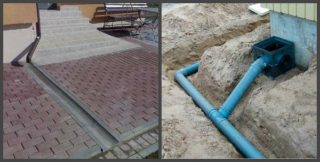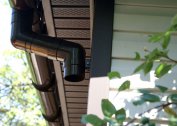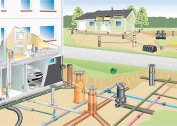So that rain / snow water does not have a negative impact on the soil and buildings, it is necessary to equip storm sewers. Correct calculations and accuracy of actions during construction work provide high-quality moisture removal from the foundation and from the soil. When installing storm sewers in a private house with your own hands, it is important to determine the type of system and the diameter of the pipes / gutters.
Types and arrangement of stormwater
According to the type of deepening, three types of drainage are distinguished:
- Recessed system (closed / spot). It assumes the presence of tanks-storm water inlets along the perimeter of the roof under the pipes and underground collector arms extending from them. According to them, rain / melt water is sent to the discharge point or to the storage tank. In the future, such drains can be used in the farm for irrigation and irrigation.
- Open (linear). It involves the installation of special trays, interconnected in an extended collector around the perimeter of the site. The trays are located on the surface of the soil, and the upper edge of their gratings is located slightly below the platform from which water is discharged. According to the law of communicating vessels, all rain runoff through the gutters eventually ends up in a large receiver. More often, open stormwater is used to eliminate seasonal water from the foundation, from garden and pedestrian walkways.
- Mixed. It involves the use of both types of sewage. More often this design is used on complex reliefs or in large areas.
The type of storm storm is determined depending on the available construction budget and soil characteristics.
Components of storm sewers
 The main elements when installing stormwater in the country on your own:
The main elements when installing stormwater in the country on your own:
- Roof drainage system, including funnels, pipes, elbows, hanging gutters;
- storm shower trays located around the perimeter of the house;
- decorative grilles to prevent debris from entering the gutters;
- point storm water inlets with sand traps;
- underground pipes for transporting effluents to a discharge point or city collector;
- revision, overflow, rotary, drainage wells.
Each of the elements performs its specific function. The exclusion of at least one of the selected type of system will lead to the failure of the entire communication.
Design and Preparation
 Without accurate and thorough design, it makes no sense to venture the construction of stormwater. The communication, mounted on random, simply can not cope with the task. Water will not leave the site. The upper layers of the soil will turn into a swampy mess. The external walls of the foundation will suffer from this and the money can be considered thrown to the wind.
Without accurate and thorough design, it makes no sense to venture the construction of stormwater. The communication, mounted on random, simply can not cope with the task. Water will not leave the site. The upper layers of the soil will turn into a swampy mess. The external walls of the foundation will suffer from this and the money can be considered thrown to the wind.
When drawing up diagrams, drawings and project documentation, it is important to consider the following parameters:
- the amount of rain and melt water that will be discharged through storm sewers;
- the average frequency of precipitation in the region - taken in the local weather service or environmental protection institution;
- the roof area in horizontal projection to divert rainwater through a point collector;
- physical and mechanical properties of the soil (for closed communication). It takes into account the type of soil, the degree of heaving.
Thanks to the data obtained, the desired diameter of the pipes / gutters for the stormwater device is determined. Recommended parameters are taken from SNiP 2.04.03 - 85 “Sewerage. External networks and facilities. ” From here they also take data on the level of the deepening and slope of the system. Parameters vary depending on the selected pipe / tray diameter.
To make storm sewers around the house, you need to draw a diagram of it taking into account the passage of existing underground utilities.This will facilitate installation and prevent damage to previously laid pipes.
The choice of pipes / trays for stormwater
After the stage of calculations and preparation of drawings, you should decide on the materials for the main elements.
- Polymers Ideal for a private system. Plastic elements are easy to operate, inert to aggressive environments, prone to linear tension and withstand moderate dynamic / static loads. In addition, the inner surface of the polymer trays / pipes is smooth, which accelerates the flow of water even with a minimal slope of the sewer.
- Asbestos cement. A good option for a storm over a large area. The material is strong, durable, has an acceptable weight and can withstand the effects of aggressive environments.
- Cast iron. An expensive, strong, durable metal with an impressive mass. Cast-iron pipes, trays, storm water inlets are more often used in city highways.
- Cast iron
- Polymer
- Asbestos cement
In private construction, polymer protective grilles can be used. They are lightweight and strong enough for moderate-intensity loads.
Stages of installation of stormwater in a private house
First of all, before starting installation work, it is worth making an accurate markup of all communication on the site. To do this, use a tape measure, pegs and construction thread. All locations of pipes, storm water inlets, wells, the final place of water collection are noted - it is located at the lowest point of the site. Further, during the construction of a closed point system, they act in the following sequence:
- In accordance with the marking, trenches and wells are digged for the installation of storm water inlets / trays. The bottom of the trenches and pits is well rammed. When digging, take into account that a sand pad 15-20 cm thick will be laid under pipes and tanks. That is, the depth is increased by this parameter. During the digging of trenches, a given bias is observed.
- Pipes are laid on a sand cushion and connected in series with couplings. All joints are preferably treated with sealant.
- Storm water inlets and wells are installed in the prepared pits if the communication has differences in relief, turns or the length of one section is more than 10 m. All elements are connected into a single system.
- When connecting storm water inlets with pipes, sand traps are immediately mounted. They prevent siltation / clogging of the system with sand and earth.
- Check the storm by pouring water into the tanks. If all the joints remained airtight and the water left at the right speed, you can backfill the system. First, it is sprinkled with crushed stone with a layer of 10-15 cm, and soil is laid on top. It is not necessary to ramp it, it will sit down over time.
When an open storm device is installed, the work is performed in the following sequence:
- Prepare trenches for laying gutters, observing the slope.
- The bottom of the grooves is covered with a sand cushion. If concrete trays are laid, then a concrete solution of 10 cm is poured onto the sand. It will serve as the basis for heavy gutters.
- Trays are mounted on cooled concrete or on a sand cushion, connecting them into an extended collector. All joints are coated with sealant.
- The installed collector on the sides is covered with rubble and well tamped.
- The gutters are covered with decorative protective grilles.
To extend the life of a closed storm shower, it is important to regularly flush it under pressure - once every 4-5 years. An open system is enough to free from garbage once a season.







